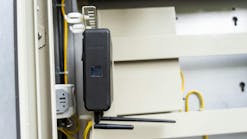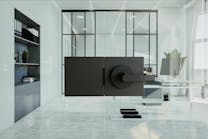The magnetic lock is well suited for numerous applications; just about any type of opening can be controlled using a magnetic lock. Be it a door, gate or even a window, there is probably a magnetic lock that will fit your customer's needs. The advantages of the magnetic lock (self aligning, low maintenance, durability, tolerance to door miss-alignment and ultra high duty cycle) will help ensure a trouble free and long lasting installation as well. So let's look at some of the most basic applications for magnetic locks, and when to use them.
CONTROLLED ACCESS
This is the most basic type of application possible. It consist of a power source, a switching device and a magnetic lock, and is commonly used in situation where life safety is not an issue or where free access / exit is not desirable. One use of this application is to control materials such as tools, supplies, jewelry or pharmaceuticals. In this situation you would normally use a medium or high security magnetic lock like the Securitron Model M62 (1200lbs dual voltage) or Model M82B (1800lbs dual voltage w/ bond sensor).
The user approaches the opening and uses a PIN number, card or biometric reader to access the materials. Once the job is completed, the materials are returned to the controlled area in the same fashion. All transactions can be logged via audit trail, providing very tight control of the materials. You can also have multiple controls on this type of system that would allow supervisory oversight to override access or allow it freely depending on the situation.
Another commons use for this application is in detention facilities where prisoners are processed. This type of system allows the movement of persons from process to process in a controlled fashion. And the high durability, low maintenance and high duty cycle of the magnetic lock keeps down time for these systems to a minimum.
FREE EXIT
The free exit application is probably the most common application for magnetic locks. In these types of systems, the magnetic lock is used to lock the door and a code compliant egress device or devices are used to release the magnetic lock for unimpeded free exit. The primary use of this application is exterior free exit doors from any type of building, be it a movie theater, auditorium, warehouse or office building.
With the many varieties of magnetic locks, finding a lock to meet the needs of your opening shouldn't be too difficult. First you need to determine the level of security required. In traffic control applications, a lower security magnetic lock with a holding force of 500 to 800 pounds is recommended when you want to limit access but security is not the main concern.
For single doors, something like the Securitron Model 32 dual voltage 600 pound magnetic lock could be used. On double doors, two locks may be used. Or a magnetic lock with a split strike assembly like the Securitron model M62-SS or M82B-SS allow the ease of a single lock installation (i.e. mounting one unit with one electrical connection) with a two strike plates to secure a double opening.
For medium or high security applications, magnetic locks with a holding force of 1000 to 2000 pounds like the Securitron model M62 (1200lbs dual voltage) or model M82B (1800lbs dual voltage w/ bond sensor) would be recommended. One thing to note in this application is door location and door type. In general you will want to use the medium to high security locks in exterior applications and the lower security traffic control locks for interior applications.
The exceptions to this rule are aluminum store front and glass doors. These doors are normally found on the building exterior but are not generally high security doors so on these applications the lower security traffic control locks or at most a medium security lock would be used. The reason for this is simple. If some one really wants to access the area, he or she won't worry about beating the lock, but instead will remove or break the glass.
Next is the selection of exit device. In general for public occupancy applications, a listed free exit device like the Securitron TSB-3 (touch sense bar) would be used to allow free and immediate exit from an opening at all times. As an alternate, UL listed exit system using a motion detector like the Securitron XMS used in conjunction with an emergency release button like the Securitron EEB2 or EEB3N can be used or may be the only option as would be the case with an all glass door where a panic device can't be easily installed.
Lastly this application can be used with or without an access control system and also gives the end user a couple of advantages over other options. Magnetic locks are high durability, low maintenance, self aligning and high duty cycle devices. On doors with high traffic, you will be hard pressed to find a better type of device. Secondly they are fail safe. This means that these openings can be released from a signal from the fire protective or building general alarm system. This allows occupants easy exit in an emergency as well as allowing emergency responders like police, fire and emergency medical easy access in emergency situations.
DELAYED EGRESS
The delayed egress application has become much more popular in recent years and the basic intent of an exit delay system is to provide a compromise between building security and life safety. It is popular as part of a loss prevention strategy for retailers and with health and nursing specialists to protect wandering patients and visitors. It is also a good way to force controlled access and egress (i.e. card in, card out) on doors that are also required for emergency exit. With this type of system, the door is locked from both the access and egress side. From the egress side initiation of this system is usually accomplished by pressing an exit device or moving the door. This starts an alarm process where the door will open after a delay period usually 15 seconds but this can be extended to 30 seconds with approval of the local AHJ. After the door is released, it can be reset and re-locked via a manual reset device like a key switch.
Exit device initiated exit delay systems lend themselves well to applications where staff uses and access control system (i.e. digital keypad, card reader, etcetera) for access and egress but the door is a means of egress in an emergency like a pass through door from a sales floor to a warehouse area or an employee entrance that doubles as an exit or a door that leads to a dementia ward or nursery in a hospital, basically anywhere you want to be able grant controlled access and egress on a door in a high traffic environment that is also an emergency exit. These systems can be a two-piece installation like the Securitron IEXD (exit delay lock) with a Securitron TSB-3 (touch sense bar) or a modular system, say a bank of four doors where you could use something like the one Securitron BA-XDT (exit delay timer), one Securitron MK (reset Key switch), four Securitron TSB-3 (touch sense bars), four Securitron M62 (magnetic locks 1200lbs) and one Securitron BPS series power supply.
Door movement exit delay systems like the Securitron IMXD (door movement exit delay lock) lend themselves well to exit only applications with existing exit devices like the emergency exits in a retail store, hospital or nursing home. With door movement, if the door is not secured with another mechanical device, access to the area could be gained by simply pulling on the door. Because of this mating with a mechanical device like a panic bar door movement is also better suited to lower traffic applications like exit only doors.
GATES
Magnetic locks have always been a good option. Because a magnetic lock is very tolerant to mis -alignment, the normal sag and movement in gates is less of an issue then it would be with a mechanical device like an electric deadbolt. If the lock is sealed and weatherproof like the Securitron M62G series locks, weathering and loss of operation are minimized. One of the other advantages of magnetic locks on gates is the fact that they can be used in different orientations for different types of gate travel so one type of lock can be used on both swinging and sliding gates. This makes device selection much easier.
INSTALLATION TIPS
As with any installation when you use a magnetic lock, there are a few things you should do to prepare. First, review the installation using building plans for new construction or a site survey and walk through for existing buildings.
Second, be familiar with the local life safety codes so you can guide an end user to a solution that will meet the facility's needs and still be code compliant.
And lastly, before you do any work, make sure you have approval from the local authority having jurisdiction.
If you follow these simple steps you will find that your installations become far less taxing and far more profitable. Remember, if you need help, it is always available from companies like Securitron who want to help you do the right thing for your customers.
Rich Hagala is Customer Support Manager for Securitron Magnalock Corp., an Assa Abloy Group company. For information on Securitron , visit the web site www.securitron.com.





